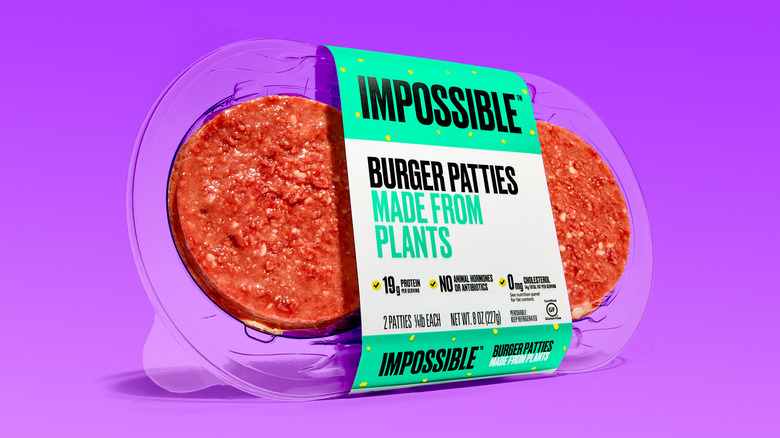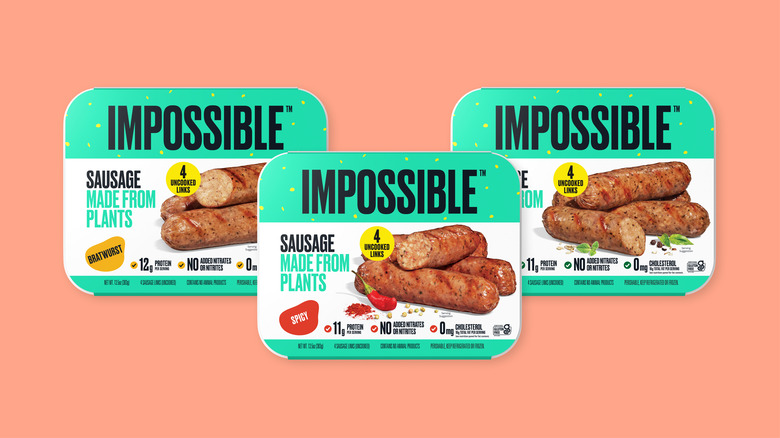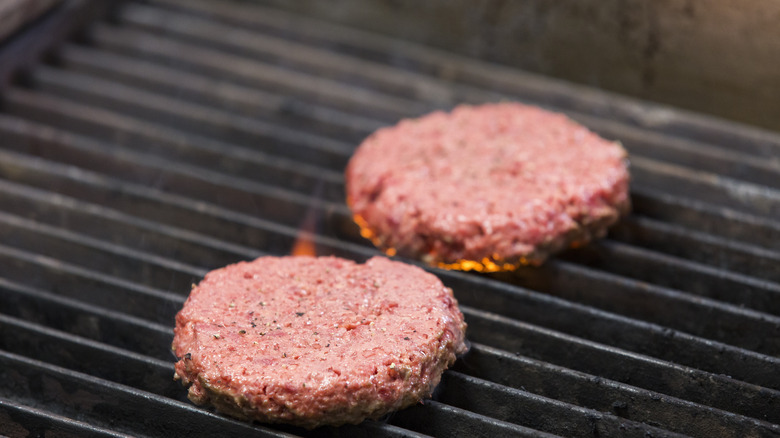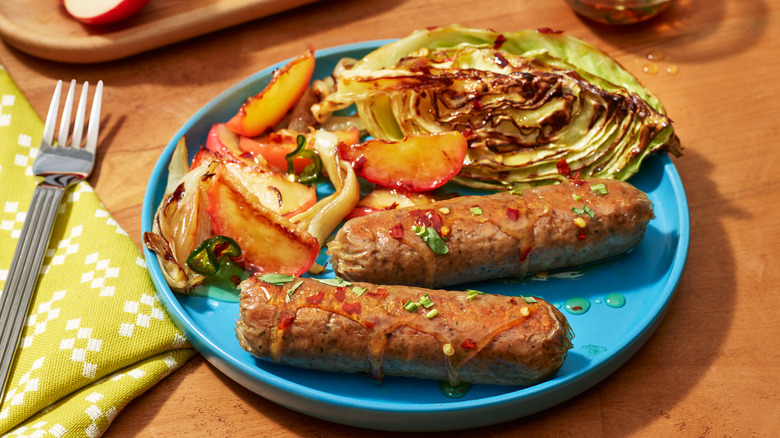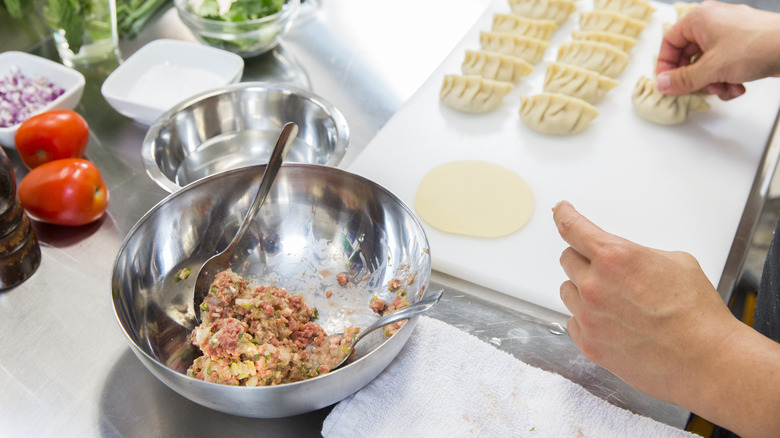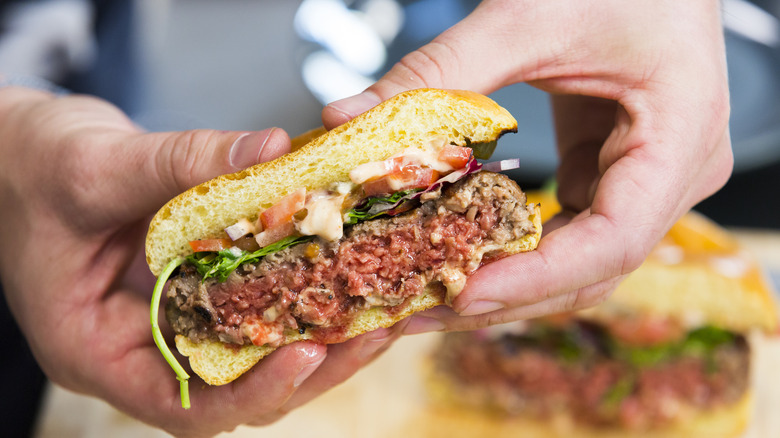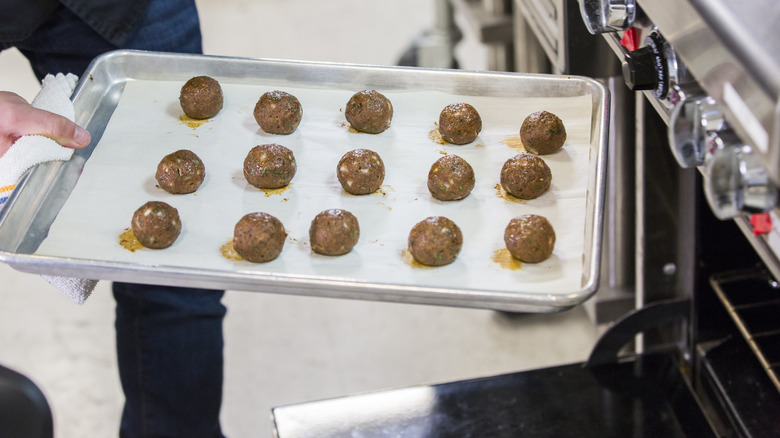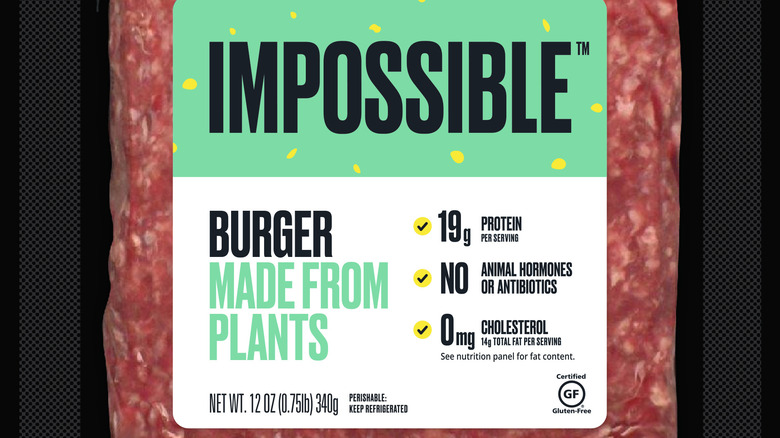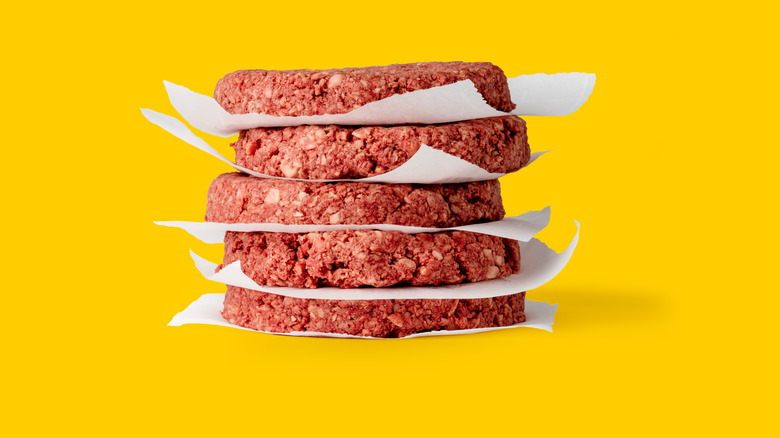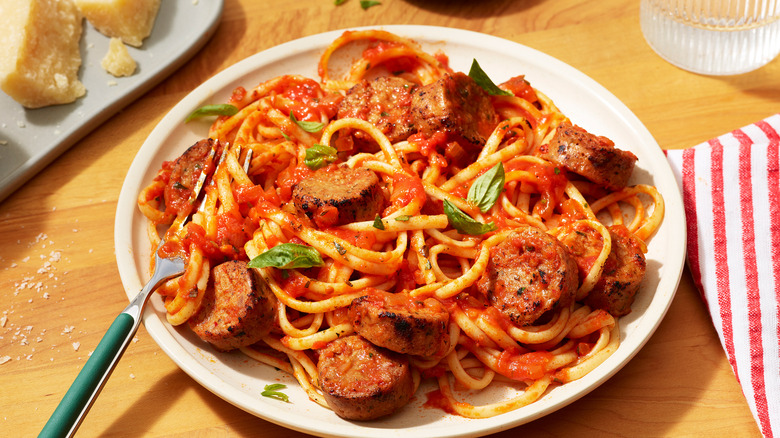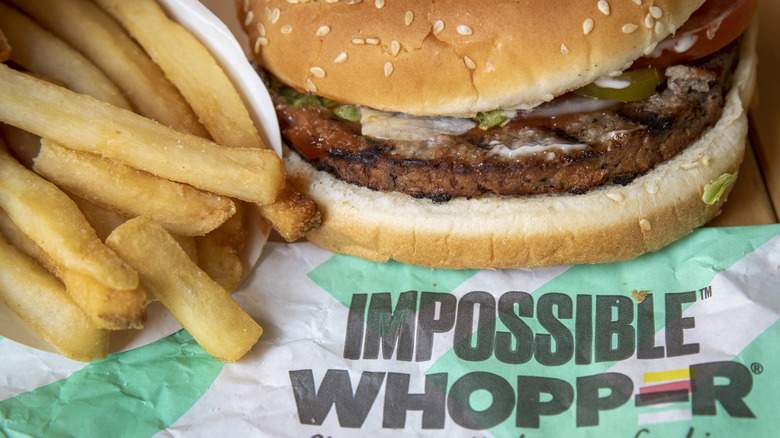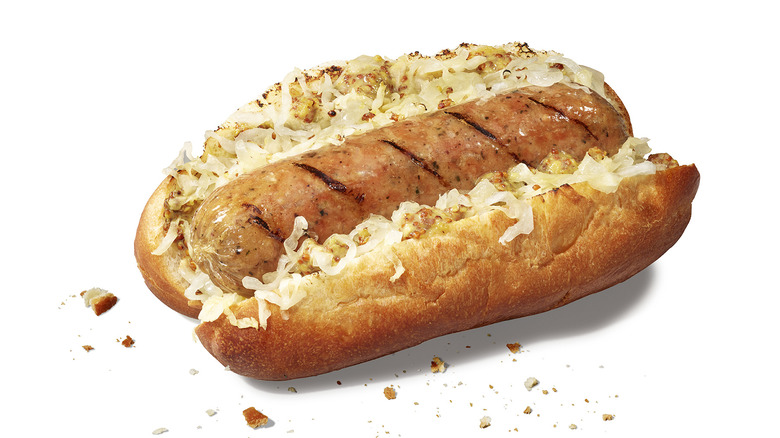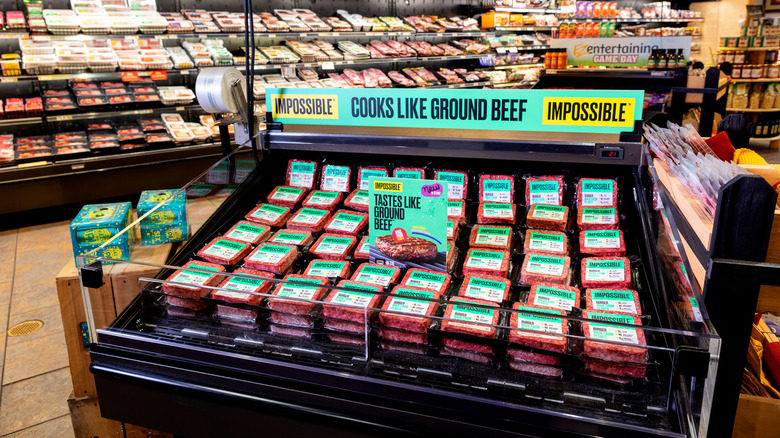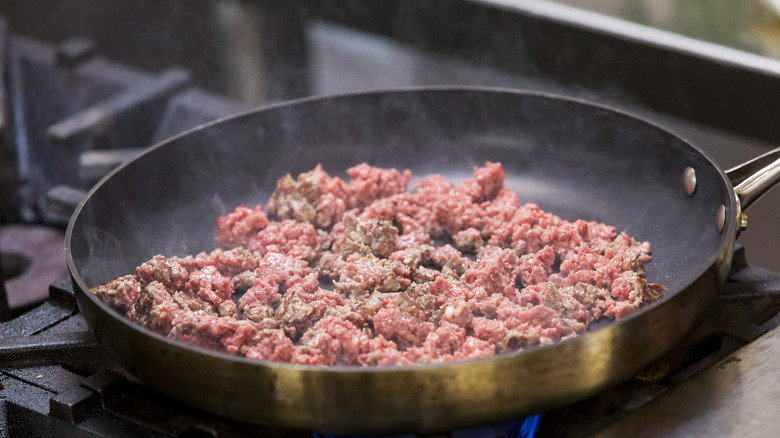Impossible Food's Chef J. Michael On Grilling, Sustainability, And Meat-Like Taste - Exclusive Interview
When it comes to juicy plant-based meat that packs a punch and truly tastes like the real thing, Impossible Foods is the way to go. The products mimic their meat counterparts at every turn — from the texture and taste right down to the way they bleed on your plate. The company first introduced customers to their Impossible burgers, and Impossible Foods has branched out exponentially from there.
Between multiple variations of the new sausage links, the Wild Nuggies that raise awareness about endangered animals, and packaged plant-based meat that you can slice up and cook with your favorite recipes, there's a whole lot to choose from. With summer on the way, barbecuing is on everyone's mind, and Impossible has more than a few options to grill at your next outdoor event or even just cook at home with the kids.
During an exclusive interview with Mashed, Impossible Food's Chef J. Michael and Product Communications aficionado Megan Collins dished on the best summer grilling tips for Impossible Foods. They also provided some tips and tricks to keep Impossible Foods' meat juicy and authentic. Chef J. Michael even dove into some sustainability hacks and what Impossible Foods is doing to help combat issues like climate change while raising awareness about consequences like endangered animals.
The Impossible sausage crack
I was blown away when I tried the Impossible sausage links. How do you make the sausage casing to get it so authentic while achieving that classic crack when you bite into it?
Chef J. Michael: We have several teams focused on every single component of every product that we produce, and that was really important to us. It was a characteristic that resonates with people when they think about sausage. We specifically honed in on that as an attribute to make sure that we delivered, and in it being the first traditionally cased sausage in the plant-based space, we feel like we delivered on so many attributes of what people really are looking for in a sausage product.
We're entering summer grilling season. What are some of your favorite tips to grill sustainably with Impossible products?
Chef J. Michael: Sustainably, gas is probably the most efficient method of grilling outdoors. Gather your mise en place and make sure that you're ready to go [when] getting out there. Don't let the embers burn too long, [and] also don't leave the gas on for too long. [There are] definitely different methods, but preparation is everything to make sure that if you are using fossil fuels or carbon, you get organized and make sure that you're ready to roll.
The best grilling tips
Do you have any grilling recipes you love to use with Impossible sausage links, Impossible burgers, and Impossible pork?
Chef J. Michael: I do. We have a litany of them. [This website link] is the place where you can get all the things that we're adding as we go. I add a ton of stuff there. We have a ton of stuff coming. We have the cookbook, which offers itself to all of our beef recipes. Who knows if we'll do more with that, with all of the variety of different products and skews that we've put out in the last 18 months. We did focus on beef for the cookbook. As we add products, we will add additional recipes on that link that I shared previously.
Do you have any favorites from those or any tips that people can use to make the most of the recipes?
Chef J. Michael: For the sausage, the one that I'm thinking about that comes to mind is brot with charred cabbage, apples, and onions. That's probably my favorite, and hot honey, that's my favorite newest one that came out. It's really, really great with that application. The thing that I focus on the most is, and it's inherent to our culinary capabilities as well, is whether or not it's formed or loose ground recipes or farses for fillings like potstickers and/or raviolis, etc. We really try to hit all those cooking methodologies with our ground products by showcasing them in different recipes, but then also, different cuisines — different day parts. We really are trying to be that no compromise alternative [for] any given situation that you have, and we've offered recipes with that thought in mind, as well.
It's all about the Impossible combos
What sides, veggies, and sauces do you suggest customers pair with these products and do you have any tips on getting them just right?
Chef J. Michael: The beauty of our products [is] that we're really trying to make sure that you are having that Indiana Jones moment where you're replacing something really quick, and it's exactly the same. I would encourage people to use what they like, and if Impossible is the only substitution that you have in a given dish or given cuisine that you're trying out, use your favorite recipe and incorporate Impossible products. That's the best introduction to it so that you're surrounded by pieces of comfort while you're trying something new, and I'm sure that Impossible will deliver and probably exceed your expectations.
Do you have a favorite recipe that you've converted with the products?
Chef J. Michael: I try to think of super traditional recipes. A classic burger was probably my first one that really drove it home for me because burgers are the most personal experience. Having a burger bar at home, you're in control of how many pickles and where the placement is, and how much sauce — not too little, not too much, getting the Goldilocks effect going on just right. It really is about personalizing your experience, so making sure that the first time you try Impossible, you're taking that into account. Turn your mind off that it's not what you think it is or knew it to be as the meat of old. It's going to deliver in the same way. If you're catering your experience to something you know and love, even the weird particulars of how many pickles, you're going to service yourself up.
Grilling in the city — without a grill
This is a totally self-serving question because I live in New York. A lot of people who live in locations like apartments don't have access to genuine grills. Do you have any hacks for people to achieve an authentic grilled taste while using a stove or something small like a George Foreman grill or another appliance instead of a real traditional grill?
Chef J. Michael: It's a great question. It's really hard to mimic grilled flavor, especially if you're using grill components. The beauty of our product design is that it works on any type of apparatus, high heat temperatures, bakeability and/or broiling for that matter, sauté, really whatever you have in terms of a cooking method, our product will react and respond in the same way that you would expect meat to.
In terms of driving those flavors, I'm sure that you could add smokey condiments, say a smokey barbecue sauce or something along those lines, in order to drive some of those characteristic components of a grill. What comes to mind in the forefront is the availability of any cooking surface or apparatus to really provide ease of use for our products. They're available to do anything.
Megan Collins: I've found cast iron skillets get a nice crust on the products, too.
I will say that I cooked the sausage links on a pizza heater I have in my room, and it worked really well. They were crispy and amazing and really juicy, so I can attest to that.
Chef J. Michael: One of the things I've tried to do with our product when they're going through the phases is try to break them — like what don't they do? That's part of our process too. It's not only delivering the sensory characteristics, the flavors, the textures, and how those come to be, but it's also like, "Do they perform?" There [are] two experiences with our product. There's from the plate to your belly, and that's a whole sensory experience, but there's also package to plate, and that culinary experience is from the time you open the package to the time you cook it and then begin enjoying it. From the time you order it, get it at the grocery store, to the time it hits your plate, we're really trying to understand and deliver against that because cooking indeed is an emotional experience.
Cooking with the kids
With kids heading home for the summer, what are some tips for cooking, grilling, and eating Impossible Foods products with kids and making it a fun and engaging experience?
Chef J. Michael: Oh man, get them involved. Not enough kids spend their time in the kitchen like I did when I was growing up. The immediacy of them enjoying the food will be there, but also, the long term [and] long-lasting effects of memories attached to specific items and dishes that they cook. Eating and sensory characteristics are one of the most powerful memories that we have, and getting kids involved — there's nothing like building something yourself and seeing your two hands really produce something on the other end that you can enjoy. I don't hear about enough kids getting in the kitchen, getting involved, and you sometimes see videos online or social media where they get involved. It creates a familial memory, and it will be attached to this food, and why not make Impossible a part of that as well?
Can you think of any recipes that really lend themselves to that process of working with kids?
Chef J. Michael: [With] any recipe that you do, there is an individual component within that recipe that a kid can absolutely participate in. It's about challenging them every single time. Kids with knives sounds pretty scary, but you'd be surprised at the carefulness that kids have. They know what's dangerous [and] they know what's not. I'm sure that there are products out there and methods that they can "graduate to," pun intended. As you move along, there's any recipe out there, whether it's squeezing a lemon over to finish or whatever it might be, there is something within a recipe that a kid can feel involved, feel important, and feel a part of the experience.
Megan Collins: I'll also say from personal experience, the very first recipe I ever remember cooking by myself was from a Rachel Ray kids cookbook, and it was meatloaf muffins and getting your hands in there. You can do the same with Impossible beef. You put the ground beef mixture into the bowl, and the kids can mix it and touch it and experience it, and it's gross in a fun kid's way.
Juice for days
One of my favorite things about Impossible Foods is the juiciness of all of the plant-based meat. How do the products achieve this meat-like quality, and what are some of the best tips to avoid losing the juice during the cooking process?
Chef J. Michael: Our products' secret ingredient or what drives the flavor and meat also drives the flavor in our product is heme. One of the most beautiful characteristics past the sensory component that it delivers is that it's transformative. It changes from red to brown as you cook it. That whole experience, if you wanted to cook a burger to medium-rare, it would reflect that visually as you cut it in half and open or if you like your burgers medium-well, it's well done, it will go towards that brownish or pink color as you cook it. The way to achieve that is to [not] overcook it. The one tip that I would give you there is [to] get a meat thermometer and temp it along the way.
Eventually, you will develop an intuition to be able to predict what temperature it is, and you'll eventually surpass the need for a meat thermometer, and you'll be able to intuitively select where you're at within the cooking process. It's all about hitting the right temperatures and not overcooking things. That's not inherent to Impossible — that's anything that you're doing. You're going to get better and better at it. Practice makes perfect. Cooking's not hard to do. It's easy to screw up, and that's why it's so beautiful.
If someone were trying to get a medium or a medium-rare on say the burgers, do you know the specific temperatures that would be best for each of those?
Chef J. Michael: It would be the same thing that you would follow for any other meat products. If you're targeting that medium-rare 130/135 [degrees], that's what you would target with our products. It's going to be exactly the same. Along the way, the other thing that I would add is, there [are] visual cues as you're cooking that you can see the difference. There [are] audible cues that you can hear the difference as something is cooking through.
Everybody's cooked a pan of cookies, right? You can smell when they're done [and] you can smell when they're overdone. Gathering your intuition around all your senses, not just relying on one thing, it can be turned in doing something else. I can hear that something is ready to flip or ready to be done. That's beyond your eyes, and people rely on their eyes so much, but every single one of your senses could absolutely be challenged in the cooking process.
Wild Nuggies for a good cause
I'm obsessed with the Impossible Foods Wild Nuggies that are shaped like endangered animals. Why do you think this is such an important topic to address, and what are some tips for cooking the Wild Nuggies?
Chef J. Michael: Start them young is the first thing, and what an accessible way to have a conversation about endangered animals while feeding them something that they know and love, like a nugget. Past that, we have beautiful Instagram accounts for each individual animal that they could follow along with, with full-on food scenes built out of different vegetables. It's important to have a not scary but distinct conversation about what kids are eating and how it affects different things, everything in stride. You really have to understand what's going on with the world, and kids today are more involved and more aware of that. We've been hidden from a lot of the facts behind food along the way, and more information is available today than ever before.
Do you have any suggestions on making that process an interactive experience for kids to learn why protecting these animals is so important in the process of cooking and eating and those kinds of things?
Chef J. Michael: I know I just plugged our Instagram accounts, but put the phones down. At the dinner table, have a conversation, engage. We spoke about it before, getting them involved in the cooking process, and I know I did that as a kid. Phones were not even anywhere to be found when I was a kid. Having a conversation, asking kids their opinion, [and] getting them involved in the whole cooking process where food comes from is so vitally important. I think that if you ask kids where something came from, they'd say the grocery store, but it starts much earlier than that. It was a beautiful thing along [with] my history, even to see a tomato grow, the flower that it buds to start, like, "What does it look like as a plant?" Broccoli's a crazy one.
There [are] so many things that you don't even know how they start because the only thing that you've seen is a rubber band around them in the grocery store, and that's your first experience on where they come from. There's a loss of appreciation and the connection to where things are built from, vegetables specifically. As plants outside of the grocery store, they're all super pretty and beautiful. We could do more for kids to understand the life cycle of how their food gets to their plate.
How plant-based meat helps the world
Climate change and the need for sustainability are critical issues the world is facing right now. How is Impossible Foods trying to combat some of these issues, and how can eating a plant-based product help these causes?
Chef J. Michael: That's core to our mission. It's our primary focus. When I look at it, I'm a chef by trade. I've cooked meat in the past, and it's been a part of my career. It's ultimately a math problem. The demand for meat grows 60% to 70% over the next 25 or so years; of all non-ice land in the world, 45% is devoted to animal agriculture. You can look at those two factors right there and understand that we can't continue on the path and sustain the growth with the resources that we have. It's hard to give up things. We all want [to have] the cake and eat it too. It's hard to stick to your New Year's resolutions but what we're offering is like have your meat and eat it too. That's the crux of it.
If you want a burger, you can have a burger. If you want nuggets, you can have a nugget. We're trying to really develop that experience so that it is that moment that you're not really giving anything up. With the greenhouse gas emissions or water or land savings that we're attaching to our products, we do life cycle analysis, and we help you to understand how each product contributes in those individual categories — how they contribute in each way against the animal. It's pretty compelling when you start to look at the factors. I know that, again, people don't like to think about the doom and gloom, but the facts are there, right? If you're not giving anything up, what is the difference? I'm asking the question, and it's rhetorical. You should think about it.
Winning over the naysayers
Which products would you recommend for people who love meat and are hesitant about trying plant-based options, and what cooking tricks are most effective in achieving a result that really tastes like meat?
Chef J. Michael: There [are] a couple of scenarios that I could add here. I do think that for your favorite meat, we're trying to offer a litany of products in order to offer you your favorite avenue. If beef is your favorite, if breakfast sausage is your favorite, if chicken is your favorite, we're trying to give you those options so that you have all the multiple options in your toolbox. I know that some people that eat chicken don't eat beef and they don't like beef, so when we offered that product, we didn't really have anything for them to replace because they didn't have that in their diet.
As it stands, incorporating it in your favorite application and your favorite way to eat said plant-based meat, it's the greatest introduction, and I really do believe that we are trying to offer that experience, and the onus is on us. We're trying to stand up to that request that the earth has given us. It's absolutely imperative that we figure out, again, how to solve that math problem.
Do you have any cooking tricks that are your favorite to use to get that?
Chef J. Michael: One of the pillars of our product identity is versatility and convenience, and some of our products lead with versatility, i.e., our raw products and some of the products lead with convenience. Those are our more value-added products or pre-cooked products. Based on your level of execution or level of culinary skill, we're offering products available for ease of access if you don't really want to go full tilt with the recipe, but we also have the versatility of our raw products that you can [use to] gain your culinary experience, or if you're a home pro, you can utilize those to form fit into your favorite recipes.
Along the way, we'll probably continue to add things so that every single consumer, whether it's popping something in the microwave or a full on three day recipe, they're going to go nuts and build everything from scratch, we'll offer those experiences, because making sure that product availability ... Protein is important but also product availability from a skillset or convenience perspective is very important and it is one of our pillars: versatility and convenience.
A plate for every palate
I love that Impossible Foods has so many variations of its products and the levels of spiciness versus sweetness. What are some of your suggestions for a sweet palate versus a savory or a spicy palate, and what sauces or condiments do you think pair well with each?
Chef J. Michael: I'm a sauce freak. I love it. It's always been my thing. It sounds like you're speaking specifically about our case sausage in this particular question, because we have the brat, the Italian, and the spicy. Why don't you buy all of them, cook them up, cut them into small pieces, and have a sauce bar and go through the different combinations, see which is your favorite? Make it an interactive experience between guests that you're having and pick your favorite. Food is so subjective, and that's the beauty of it. You can't be things to all people. You can't do it, no matter what you're doing. To make it an interactive experience and test different things, pull the refrigerator door of sauces out and go nuts.
Do you have any personal favorite combinations?
Chef J. Michael: I love sweet and savory. It is absolutely ... I said it before, the charred cabbage, apples, and onions with the hot honey and the savory brat. That was a recipe that I recommended earlier. There's nothing that's better than sweet and salty for me. I've always loved that combination, savory [and] sweet together. There's something about it that is incredibly cravable to me.
Impossible meets fast food
What are some of your favorite fast food or restaurants that carry Impossible products, and what's your go-to order at some of those places?
Chef J. Michael: I'm moody. I probably go through fits and starts, and I probably change my order all the time based on my mood, and I'm sure that other people [can] relate to that. Not only because I was involved and along the ride with these products, but the accessibility of, say, Burger King and Starbucks is so great that you can get it anywhere in the United States. That approachability is awesome.
I'm going to plug some partners here because they [do a] great job: Disney with the Inventive Styles, they did a pressed Korean short rib out of our beef products. That's super cool and it elevates the idea of how you can use this, and I've worked with them as well. I'm like, "Hey, flex it. We're putting this out so you never know what we could continue to do with these products so keep trialing, keep going." We have the Impossible Shop, which is our own namesake powered by Doghouse, and I know that they do a great job in their own right but there's some killer menu items there.
I love the small mom and pops because they have the, honestly, the flexibility, and they're able to be nimble and try different things and cook from scratch. There's a little bit more control on a smaller scale, so the beauty of Impossible is it's the common denominator. We launched with David Chang and Momofuku Nishi, and then it ends up on Burger King. It's the same product behind both of those doors. The only similarity between those restaurants before that was maybe cleaning products. To have the same protein behind the doors of a top-end restaurant or a QSR, it's incredible. We are the common denominator. We're bringing restaurant similarities together, and it's so important that we showcase that Impossible is that common denominator.
The best restaurants to eat an Impossible burger
Megan, did you have any favorites?
Megan Collins: Slutty Vegan is one of our amazing partners. Shaq actually just did a whole episode with [Rip Michaels] where he was talking about how Pinky Cole, she's the chef and owner there, she's responsible for helping him go plant-based, and all of their burgers are made with Impossible. Same with Moonburger. They're this really small upstate New York burger restaurant, similar to an In-N-Out, where they have a very limited menu, and again, it's only Impossible burgers, but it's so good. They actually got this glowing profile on the Wall Street Journal. They have a bunch of celebrity chef investors.
Chef J. Michael: Shout out to all of our partners because, honestly, the early adoption and incorporation of our products is really what drove the understanding and availability across the board. It's what powered us in the beginning. We went a long time withstanding without being in retail, and they believed in us. We greatly appreciate all of our partners for doing that because it really is what changed the minds of consumers out there.
Getting the boardwalk ambiance at home
With the pandemic still raging on, a lot of people are abstaining from going to crowded places like boardwalks or amusement parks. Do you have any tips for recreating those kinds of food offerings at home with Impossible products?
Chef J. Michael: When I think of amusement park, I immediately go to funnel cake, and I'm trying to think about how that would manifest from an Impossible perspective.
Sausage is pretty big...
Chef J. Michael: Well, yeah. Food is memorable, and you have those latent food memories that began however young you were, wherever you were. No matter what you're talking about, it's always fun to recreate a food memory based on whatever experience that you had. Decorate your home to make it a full-on experience, but we, again, are offering products that have the availability to form fit to those experiences, recipes, and most fond food memories.
Megan was telling me a little bit about how you were making the sausage links. Can you walk me through that process a little bit?
Chef J. Michael: A lot of plant-based products of old tend to wrap. There [are] sausage links with whatever casing that they chose. This is the first traditionally cased sausage, so it's traditionally stuffed as you would stuff a traditional sausage from the animal. We thought that [it] was very important to get the aforementioned snap, the overall cooking experience, and it's a great rendition. We don't put things out unless they're as good or better than the animal.
In that sense, we're always continuing to evolve and understand how we can make our products better. What are the drawbacks? What are the pros? What are the cons? How can we make it better? We're our own best [and] worst enemy for that because we're trying to set the benchmark for ourselves. In any sense, I find it very important because I find a personal connection to that because I'm always trying to get better myself, no matter what the category. To have an ethos [of] that nature as a company, it's really a pleasure to work with Impossible Foods.
Rolling out more Impossible products
I wasn't able to find a lot of the grocery products offered near me in New York City, and I know my friend was trying to find some products in Canada. Are there any plans to roll out more product location offerings within the US and even other countries?
Chef J. Michael: Yeah, absolutely. We're always working on it. We can't meet our mission without being everywhere and being everything. One tip: we have a locator on our website. You can plug in your zip code, and it will offer you both food service and retail locations, product-specific, and where you can find them. The plans are big. Anything and everything is what we're after, and as we're working on things, it's important that we cast these wide nets and make sure that the product availability and product experience [are] meeting the need that's out there. There [are] more options than ever before.
Are you guys working on anything that you can tease or talk about?
Chef J. Michael: It's a powerful question, and it's not a cagey response. We literally are working on everything, and in sequence, and [will only reveal] when they're ready because we are so scrutinous around the quality and experience of our products, some things are harder than others, some things are more challenging than others as a product experience. I don't say it to be cagey but absolutely, everything. We're working on everything. We figured out the building blocks of how to do ground meat with our flagship product beef, and then we rolled out pork in food service and then pork sausage in both food service and retail. Then, we used that ground technology to produce our chicken.
Along the way, we are elevating our understanding of each component as we build a product, and it helps us to accelerate all of our technology behind our food. At the end of the day, it is food. It has to taste good. It has to perform like food. In that sense, as we get closer to things, we're targeting specific things along the way, but there's so much to target that it's about making sure that we focus on the building blocks. To again, provide our onus, it's on us to produce these products and make sure that we're meeting the need and the emotional experience that we're trying to capture for everyone that is looking for a plant-based alternative and specifically those that deliver in the same way, characteristically, as meat does.
Never giving up
Have there been hurdles or something that you tried that didn't work out for some reason or that you had to pivot on?
Chef J. Michael: Of course, fail fast. That's what they tell you in life. That's what they tell you with the development of our products. We had a 1.0, [and] we scaled to a 2.0. Previously, it wasn't available [in] high heat temperatures. It was pretty precious in [the] sauce. It was a little finicky and fussy with specific applications. We fixed all that. It goes to show you that's the most exemplary option that I can provide you to say that we will transition, and we will get better in every category. When it's ready, we'll put it out.
When it's better, we'll put it out. As it stands, there were plenty of things along the way that weren't as good but ... you can't change the animal. One of the most curious questions that I've heard asked about our products is, "Is there something about meat that we don't like that we could omit?" I know we always talk about what we can do to achieve that bar and the animal version is always our north star, but is there a way to surpass our experience that we have in our mind? Can we go past that and offer something that's completely new in the same category but completely different in the same sense? It's such an interesting question because as a chef, as somebody who is really keen on providing new experiences, that's such a curious question. It's so fun to think about, "What can we do?"
It's really interesting. Is there anything else that you guys wanted to talk about or address or plug or anything?
Chef J. Michael: Leading up to this, Megan was asking me some questions, and I know I've peppered it in here, but food is an emotional experience and what we're trying to do is make sure that Impossible is expected at your summer grill, is expected when you think about a burger or a chicken nugget or a link sausage. Our devotion to creating the most exemplary products of the animal version ... food is so emotional, it's so traditional, and that's going to be the hardest hurdle for us, but we're up for the challenge. It's an interesting thing to work towards, and we've provided multiple examples of how we are approaching that.
Customers can search for Impossible products and restaurants here. And for some Wild Nuggie fun, customers can follow the Instagram pages for Wanda the Whale, Rhonda the Rhino, Tommy the Tortoise, and Paul the Polar Bear.
